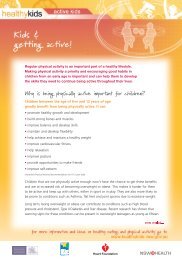I Move We Move - Good For Kids - NSW Government
I Move We Move - Good For Kids - NSW Government
I Move We Move - Good For Kids - NSW Government
You also want an ePaper? Increase the reach of your titles
YUMPU automatically turns print PDFs into web optimized ePapers that Google loves.
Putting together a fundamental movement skills learning experience for preschoolers:<br />
A summary of the steps<br />
In this section we have described the process of fundamental movement skills development and<br />
the importance of adults in facilitating this process. Specifically we have described the importance<br />
of daily, adult guided opportunities, of verbal prompts and the inclusion of a warm up, games<br />
and a cool down as part of an adult guided fundamental movement skills learning experience (see<br />
Figure 5.2, page 5.8). Below we outline a summary of the steps you may find useful when putting<br />
together a fundamental movement skills learning experience for preschoolers:<br />
1. Get to know what each skill looks like (see Figure 5.3, page 5.11)<br />
2. Plan and set-up the learning experience (time, space, equipment, content)<br />
3. Engage children’s interest in the learning experience (provocation)<br />
4. Undertake a skill-specific warm up (see page 5.8 and The Physical Activity Handbook –<br />
Preschoolers, page P.15)<br />
5. Provide a demonstration of the skill (see your fundamental movement skills lanyard) but don’t<br />
verbally explain it. Keep the demonstration short and simple. If preferred, ask a competent<br />
child to demonstrate<br />
6. Allow time for children to explore the skill and ask questions to guide their discovery. <strong>For</strong><br />
example for the skill of kicking a ball, provide balls and ask the children to “Show me how<br />
many different ways you can use any part of your foot to kick the ball”, prompting if needed –<br />
“your toes, the top of your foot/your shoelaces, each side, your heel” 23<br />
7. Provide a demonstration focusing on key skill components and explain by providing or<br />
co-creating teaching cues with the children<br />
8. Start the game or activity where children practice the skill<br />
9. Allow some time for children to have a go first then, either as they are performing the skill or<br />
directly after; use verbal prompts to provide feedback<br />
10. Extend and challenge by prompting children to use preferred/non-preferred hand/foot,<br />
increasing/decreasing distance, working to a time constraint<br />
11. Undertake a cool down (see page 5.9 and The Physical Activity Handbook – Preschoolers,<br />
page P.20)<br />
I <strong>Move</strong> <strong>We</strong> <strong>Move</strong>, The Guide Edition 1 August 2009<br />
AREA HEALTH SERVICE<br />
5.10




